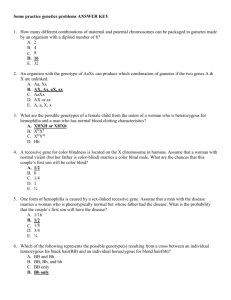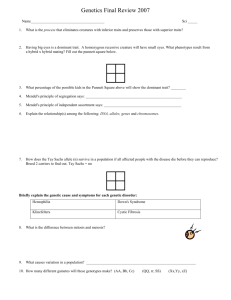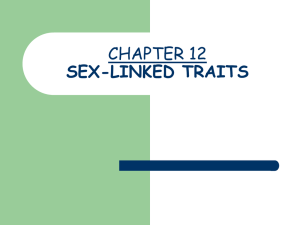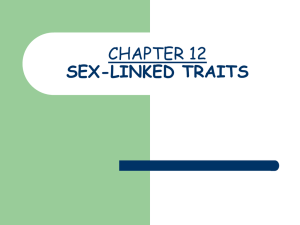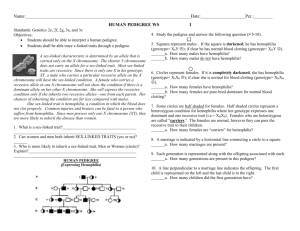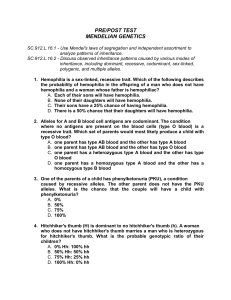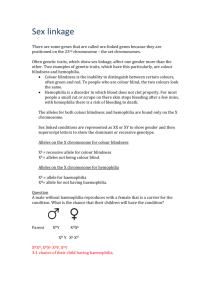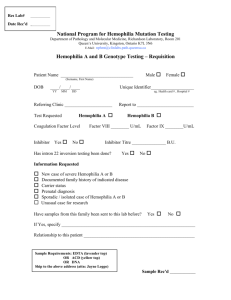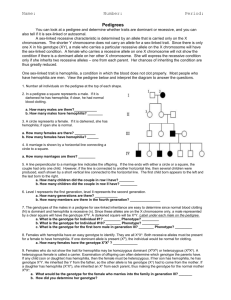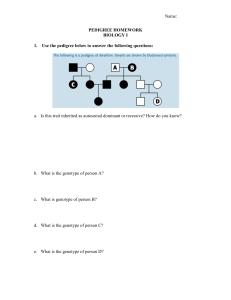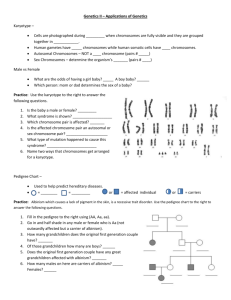A sex-linked characteristic is determined by an allele
advertisement
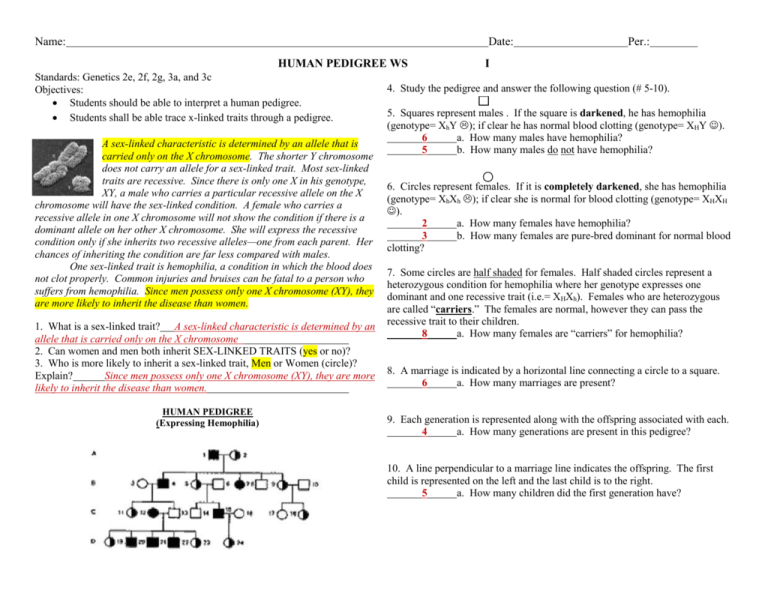
Name: Date: HUMAN PEDIGREE WS Standards: Genetics 2e, 2f, 2g, 3a, and 3c Objectives: Students should be able to interpret a human pedigree. Students shall be able trace x-linked traits through a pedigree. A sex-linked characteristic is determined by an allele that is carried only on the X chromosome. The shorter Y chromosome does not carry an allele for a sex-linked trait. Most sex-linked traits are recessive. Since there is only one X in his genotype, XY, a male who carries a particular recessive allele on the X chromosome will have the sex-linked condition. A female who carries a recessive allele in one X chromosome will not show the condition if there is a dominant allele on her other X chromosome. She will express the recessive condition only if she inherits two recessive alleles—one from each parent. Her chances of inheriting the condition are far less compared with males. One sex-linked trait is hemophilia, a condition in which the blood does not clot properly. Common injuries and bruises can be fatal to a person who suffers from hemophilia. Since men possess only one X chromosome (XY), they are more likely to inherit the disease than women. 1. What is a sex-linked trait? A sex-linked characteristic is determined by an allele that is carried only on the X chromosome 2. Can women and men both inherit SEX-LINKED TRAITS (yes or no)? 3. Who is more likely to inherit a sex-linked trait, Men or Women (circle)? Explain? Since men possess only one X chromosome (XY), they are more likely to inherit the disease than women. HUMAN PEDIGREE (Expressing Hemophilia) Per.: I 4. Study the pedigree and answer the following question (# 5-10). 5. Squares represent males . If the square is darkened, he has hemophilia (genotype= XhY ); if clear he has normal blood clotting (genotype= XHY ). 6 a. How many males have hemophilia? 5 b. How many males do not have hemophilia? 6. Circles represent females. If it is completely darkened, she has hemophilia (genotype= XhXh ); if clear she is normal for blood clotting (genotype= XHXH ). 2 a. How many females have hemophilia? 3 b. How many females are pure-bred dominant for normal blood clotting? 7. Some circles are half shaded for females. Half shaded circles represent a heterozygous condition for hemophilia where her genotype expresses one dominant and one recessive trait (i.e.= XHXh). Females who are heterozygous are called “carriers.” The females are normal, however they can pass the recessive trait to their children. 8 a. How many females are “carriers” for hemophilia? 8. A marriage is indicated by a horizontal line connecting a circle to a square. 6 a. How many marriages are present? 9. Each generation is represented along with the offspring associated with each. 4 a. How many generations are present in this pedigree? 10. A line perpendicular to a marriage line indicates the offspring. The first child is represented on the left and the last child is to the right. 5 a. How many children did the first generation have? Name: Date: HUMAN PEDIGREE WS Per.: I Applying the skill: Translate the following symbols into a genotype and phenotype, and assess the health status of individuals with sexlinked traits. Symbol Genotype Analysis: Use the pedigree above to answer questions #11-13 11. Why did family members in the second generation experience some 14. form of hemophilia? XhY Both parents carried an affected x chromosome. The father would give Xh () to his daughters and a Y to his sons (). The mother had a 50% chance of giving Xh () or XH () to her children. 12. 2 Phenotype Hemophilia, Normal, or Carrier. Affected or NOT Affected Hemophilia Normal Carrier Normal Hemophilia 15. XHXH 16. a. How many children did couple 3-4 have? b. Why did child #11 receive a recessive hemophilia trait and #13 did not? XHXh 17. Child #11: Her father’s genotype is XhY (). All X’s are recessive and since she is a girl that is the only Xh. XHY 18. Child#13: Despite the father having hemophilia, ALL sons will avoid the disease. ALL sons will receive a Y from dad (). 13. Child #13 did not have hemophilia and the family history with hemophilia could have ended with him. Why did his children end up with hemophilia? Child #13 fell in love with a woman with hemophilia (XhXh). A very-very unlikely scenario and he should have seen the symptoms ahead of time. XhXh
